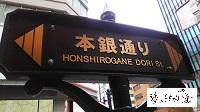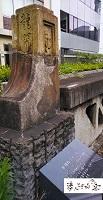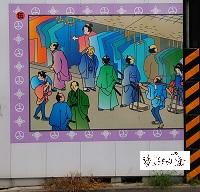"Honshirogane Street" is the most recently named street among the many nicknamed roads in Chuo Ward. Born in 2015 (2015). It is a 520m journey from 4-2 Nihonbashi Honishicho to 4-6 Nihonbashi Honmachi.
Nearly 100 years later, the name of the revived "Honshirogane" was packed with impressive episodes.

♪ Honshirogane Town
In the Edo period, on the border with Kanda, facing Kandabori and outer moat, there was a town called Hon-Shiroganemachi. It is the northern half of the current 4-chome Nihonbashi Honishi-cho, Nihonbashi Muromachi, and Nihonbashi Honmachi. The name of the town is derived from the fact that silver craftsmen lived and the fact that they were named after a book to distinguish it from Shin-Shiroganemachi, which later stood in Kanda.
Honshiroganemachi, which was a townhouse extending east and west, has developed greatly as a townman area that meets the consumption demand of samurai. Various masters of various occupations, such as sword wakizashi work, sewing foil shop, and fingermono shop, lived there.
By the way, Kandabori is also called "Ryukan River". It was a digging built between Nihonbashi and Kanda, and there were six bridges in Honshiroganemachi.
Now, let's introduce two bridges where you can get a glimpse of the lifestyle at that time.
♪ Imagawa Bridge
Imagawa Bridge was a very important bridge from Nihonbashi to Nakasendo. It is said that it was named during the Tenna era (1681-83) because it was built by the efforts of the lord of this area, Zenemon Imagawa.
Around the bridge, there were many merchants who were particular about pottery (Setomono), and it was very busy. The "Edo Jugumi wholesaler handbook" lists the names of Nishimuraya Kanbei at 1-chome Hongincho and Yakabei Imagawa at 2-chome and 3-chome as Setomono wholesalers.
 ♪ Ryukan Bridge
♪ Ryukan Bridge
Ryukanbashi (Ryukanbashi at that time) was a wooden bridge during the Edo period, but in 1926 (1926), the bridge rebuilt by the earthquake reconstruction project was a very valuable cultural property as "Japan's first reinforced concrete truss". It has become.
The streetcar passed over the bridge, so efforts were made to maintain strength. Another feature of the earthquake reconstruction bridge is that the abutment protrudes from the seawall to emphasize the presence of the bridge, but in the case of Ryukan Bridge, its characteristics are remarkable.
A part of Ryukan Bridge still remains in the former Hashizume Square. (Location: 4-chome, Nihonbashi-Honishicho, Chuo-ku, 2-3-chome, Uchikamida, Chiyoda-ku)
♪ Sweeping
I found an interesting picture at a construction site near the former Ryukan Bridge.
A picture of the Edo period drawn on the soundproof wall. They are lined up with kimonos at the store. It seems to have depicted the bustle of the second-hand clothing store, but what should be noted is its border. The ward chapters of Chuo-ku and Chiyoda-ku are treated as collaborations.
It seems that you can hear the lively traffic of people and the rich human activities that the bridge connects.

The name of the town "Honshirogane" was lost due to the Taisho era earthquake reconstruction project, but the street that runs east and west through the town has been protected to this day.
Hongin-dori, which I walked this time, was a wonderful street that fulfilled the desire of the local people to regain the historic town name.
Correspondent Minato kid, Chuo-ku Tourism Association

No. 21 September 11, 2018
 In 1606 (1606), with the expansion of Edo Castle, Kanmu Magome served as the guardian of Takarada Village and moved to this area with the residents. After that, we will stand up the large Temmacho.
In 1606 (1606), with the expansion of Edo Castle, Kanmu Magome served as the guardian of Takarada Village and moved to this area with the residents. After that, we will stand up the large Temmacho.


